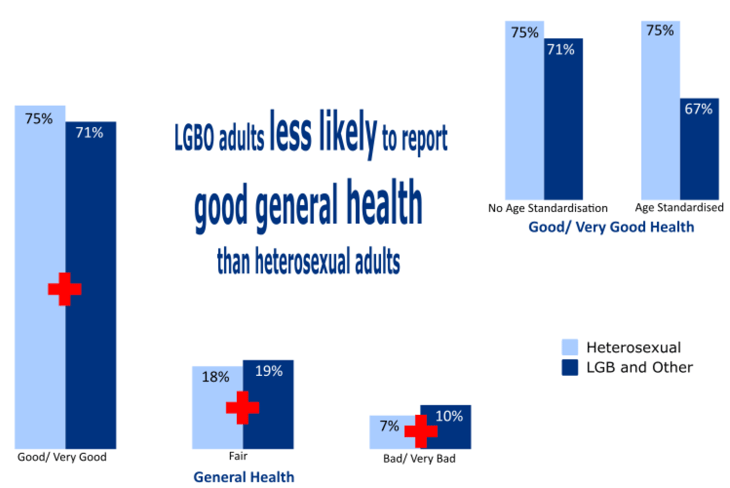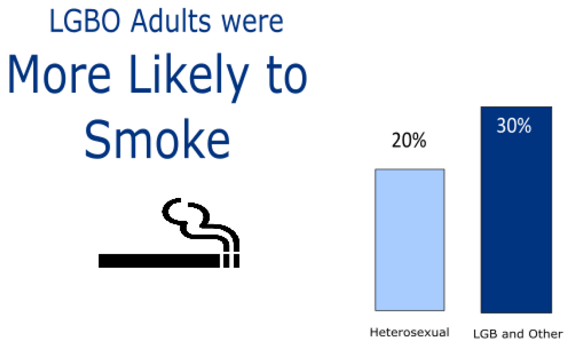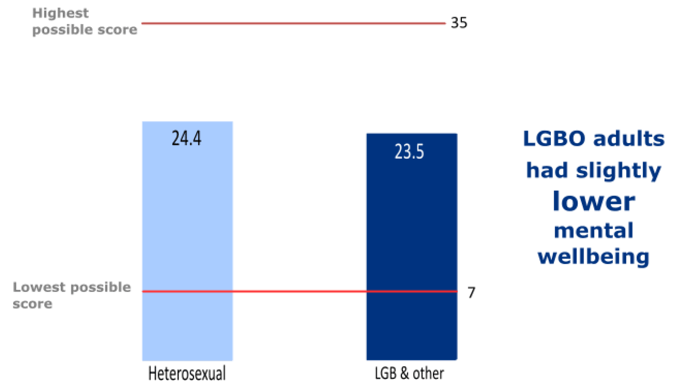Sexual orientation in Scotland 2017: summary of evidence base
Summary report of statistics and research on sexual orientation in Scotland.
4. Health and Wellbeing
This section provides an overview of Health and Wellbeing evidence for lesbian, gay, bisexual and other adults. It provides some key statistics from the SSCQ 2015 data and then a brief overview of the literature on sexual orientation health and wellbeing.
i. Summary of Scottish Survey Core Questions 2015 Data
Figure 8: General Health by Sexual Orientation - Scotland 2015

Source Scottish Core Survey Questions 2015
In the SSCQ, respondents were asked to self-assess their general health. This is used as a measure of the overall health of the population, as well as for identifying health inequalities. Figure 8 shows that LGBO adults were less likely than heterosexual adults to report good general health. Only 71 per cent of LGBO adults recorded good or very good health compared to 75 per cent of heterosexual adults. And 10 per cent of LGBO adults recorded bad or very bad health compared to seven per cent of heterosexual adults. Since health is associated with age, and LGBO adults tend to be younger, it is helpful to analyse age-standardised results. When the results for good/ very good health are age-standardised the difference between the LGBO adults and heterosexual adults is even greater - the difference increases from four percentage points to eight percentage points.
LGBO adults were more likely to report a long term limiting condition (26 per cent) than heterosexual adults (23 per cent) despite having a younger age profile.
Figure 9: General Health by Sexual Orientation - Scotland 2015

Source: Scottish Surveys Core Questions 2015
Reducing smoking is a major priority for improving health. In Scotland, tobacco use is associated with over 10,000 deaths (around a quarter of all deaths) and around 128,000 hospital admissions every year. Figure 9 shows that LGBO adults (30 per cent) were more likely to smoke than heterosexual adults (20 per cent).
Figure 10: Mental Wellbeing by Sexual Orientation - Scotland 2015

Source: Scottish Surveys Core Questions 2015
Wellbeing is measured using the Short Warwick-Edinburgh Mental Wellbeing Scale ( WEMWBS) questionnaire and measures how adults function. For example, the scale measures whether a person has been thinking clearly or whether they are dealing with problems well. Scores for mental wellbeing range from seven for the lowest levels to 35 for the highest. Figure 10 shows that in 2015, LGBO adults had lower mental wellbeing than the heterosexual group - a score of 23.5 compared with 24.4 (statistically significant at the 95 per cent level). Age-standardisation adjusted the score for the LGBO group upwards slightly to 24.0, meaning this difference is not significant.
The provision of unpaid care is a key indicator of care needs and has important implications for the planning and delivery of health and social care services. In 2015 a similar proportion of LGBO and heterosexual adults provided unpaid care (18.9 and 18.2 percent respectively).
For more information on General Health and Sexual Orientation, see the Scottish Survey Core Questions [13] web page.
ii. Summary of Literature on General Health, Mental Wellbeing and Sexual Orientation
Research suggests that LGB people in Scotland can experience discrimination when using services, and healthcare is a key service where this has been reported. For example, 25 per cent of LGBT respondents reported experiencing discrimination when accessing services (Scottish LGBT Equality Report - Equality Network, 2015: 6), with 21 per cent experiencing this when accessing healthcare (Equality Network, 2015: 26). 22 per cent were uncomfortable about disclosing their sexual orientation (or gender identity) to healthcare staff (Stonewall, 2014a: 10) and 55 per cent of LGBT people experienced wrong assumptions being made about their sexual orientation (or gender identity) by healthcare staff in Scotland (Stonewall, 2014a: 7). Hudson-Sharp and Metcalf (2016) suggest that discrimination can result from lack of knowledge or inappropriate responses from health care professionals.
Studies have also considered the poorer general health of LGB people. A UK-wide literature review shows that the causes of poor general health in LGB groups is unclear and could be either due to mental or physical ill health (Hudson-Sharp and Metcalf, 2016).
The SSCQ 2015 supports other findings that LGB adults have lower levels of good health than the heterosexual population. This is particularly marked when the younger age population of the LGB and Other group is taken into account using age-standardisation (67 per cent have good or very good health compared with 75 per cent for heterosexual adults).
LGB people are more likely to smoke or take drugs or alcohol (Hudson-Sharp and Metcalf, 2016). Hudson-Sharp and Metcalf (2016: 43) cite a Public Health England study which shows that young gay and bisexual men were 2.4 times more likely to smoke in comparison with heterosexual men.
Significant differences between smoking rates in the heterosexual group compared with the LGB and Other Group can also be seen in the SSCQ 2015 data. Given that the LGB and Other Group is younger, their increased likelihood to smoke reflects the Public Health England study.
While there is no conclusive evidence to show that the mental wellbeing of LGB people is worse than that of heterosexual people, some UK studies showed comparable levels of mental health problems between LGB and heterosexual groups, while other studies showed a difference, with bisexual people in particular showing poorer mental health and suicide attempts (Hudson-Sharp and Metcalf, 2016). There is also evidence to suggest that younger LGB people are more prone to poor mental wellbeing (Hudson-Sharp and Metcalf, 2016).
While mental wellbeing was lower for adults who are LGB and Other, the SSCQ 2015 data does not suggest that age is a factor in this. This may be due to different methods used to measure wellbeing, e.g. measuring depression rather than wellbeing.
LGBT people report that mental health services do not always meet their needs (Hudson-Sharp and Metcalf, 2016). Scottish respondents described how healthcare providers are not aware of the needs of LGBT people or provide appropriate services which ensure equal treatment (Equality Network, 2015). Stonewall (2014a: 6) highlighted that 25 per cent of LGBT people found mental health services to be 'poor' or 'extremely poor'. The same study found that 18 per cent of LGBT people expected discrimination from these services Stonewall (2014a: 10).
Contact
Email: Jon Hunter
There is a problem
Thanks for your feedback